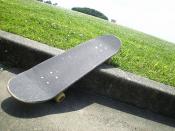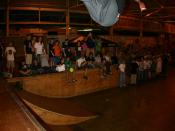SKATEBOARDING HISTORY
The first skateboards were actually more like scooters, with the undercarriage consisting of rollerskate wheels attached to a two by four. Once the pushbar of the scooter-like contraption was broken off, skateboarding was born.
It wasn't until the 1950's, when the surfing craze was in full swing, that people realized skateboarding could recreate the feeling of riding a wave. This connection with surfing gave skateboarding a direction that would influence everything to come, from maneuvers and style, to terrain, fashion and attitude. It was during this time that modifications were made to the trucks making it easier to maneuver. By 1959 the first Roller Derby Skateboard was for sale.
In the early 1960's companies such as Larry Stevenson's Makaha and Hobie Alter's Hobie began to mass-produce the first true surfing-inspired skateboards. Some of the early proponents of surf-style skateboarding included Bill and Mark Richards, Dannu Bearer, Bruce Logan and Torger Johnson.
Skateboarding became very popular almost overnight, and companies were fighting to keep up with demand. Over fifty million skateboards were sold within a three year period, and the first skateboard contest was held in Hermosa Beach, CA in 1963. Then in 1965 a slew of so-called safety experts pronounced skateboarding unsafe - urging stores not to sell them, and parents not to buy them. The skateboarding fad died as quickly as it had started, and the sport entered its first slump. Skateboarding would experience other slumps in its history. This pattern of peaks and valleys would come to be known as the "ten-year cycle," although the slumps weren't exactly ten years apart.
It was during this first slump that Larry Stevenson invented the kicktail, and the first generation of skateboarders laid down the foundation of tricks and style. However, they were still largely limited by equipment.


